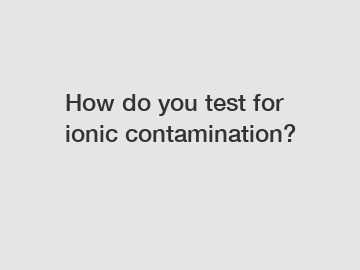How do you test for ionic contamination?
How do you test for ionic contamination?
Ionic contamination refers to the presence of soluble ionic species on the surface of electronic components, which can lead to serious reliability issues. This contamination can occur during various manufacturing processes, such as cleaning, soldering, or handling. It is crucial to detect and quantify the level of ionic contamination to ensure the quality and reliability of electronic devices. In this article, we will delve into the methods used to test for ionic contamination and explore their significance in the electronics industry.
There are several methods employed to assess and measure ionic contamination, each with its own advantages and limitations. Let's discuss some of the common techniques used:

1. Ion Chromatography (IC):
Ion Chromatography is a widely utilized technique for detecting and quantifying ionic contamination. It works based on the principle of separation and identification of different ions in a liquid sample. IC can accurately measure trace levels of anions (such as chloride, sulfate, and nitrate) and cations (such as sodium, potassium, and calcium) present on the surface of electronic components. This method provides valuable data about the type and concentration of ionic species, helping manufacturers identify potential sources of contamination.
2. Surface Insulation Resistance (SIR):
SIR testing evaluates the electrical resistance of a surface film or coating when subjected to a voltage bias. It measures the ability of a surface to resist the formation of current-leaking paths due to ionic contamination. SIR testing is particularly useful for assessing the cleanliness of printed circuit boards (PCBs) and soldered joints. By subjecting the samples to a controlled humidity and temperature, manufacturers can simulate real-world conditions and determine the level of insulation resistance. This method helps identify whether the levels of ionic contamination are within acceptable limits.
3. Resistivity of Solvent Extract (ROSE):
ROSE testing involves immersing a sample in a solvent and measuring the resistivity of the extracted solvent. The resistivity value is then used to calculate the concentration of ions present on the surface. This technique is commonly used in the semiconductor industry, where high-purity levels are crucial. ROSE testing is quick and provides reliable results, making it a popular choice for quality control in electronic manufacturing.
4. Conductivity Testing:
Conductivity testing measures the electrical conductivity of a sample or solution, which is directly related to the presence of ionic contamination. This method involves immersing the sample in a conductive liquid and measuring the electrical response. Conductivity testing is straightforward and can quickly indicate the presence of contamination. However, it may not provide detailed information about the specific ionic species present.
In conclusion, testing for ionic contamination is a critical step in the electronic manufacturing process. By employing techniques such as Ion Chromatography, Surface Insulation Resistance, Resistivity of Solvent Extract, and Conductivity Testing, manufacturers can identify and quantify the level of contamination on electronic components. This information is invaluable for ensuring the reliability and performance of electronic devices. Implementing proper testing protocols helps manufacturers detect potential issues early on, allowing them to take corrective actions and deliver high-quality products to consumers. As the electronics industry continues to advance, the importance of robust ionic contamination testing methods will only grow, ultimately safeguarding the longevity and functionality of electronic devices.
If you are looking for more details, kindly visit x ray counter, Fully Automatic Voltage Internal Resistance Tester, uv laser cutter.


